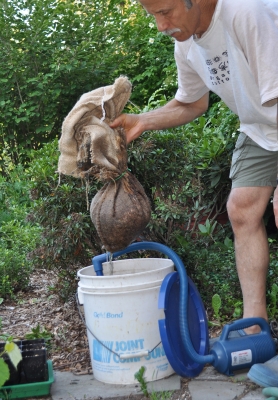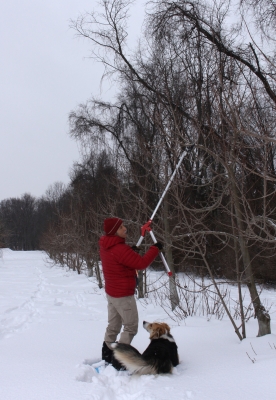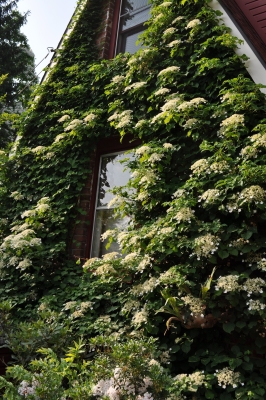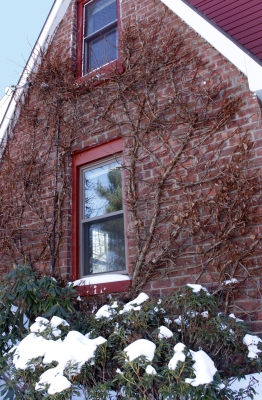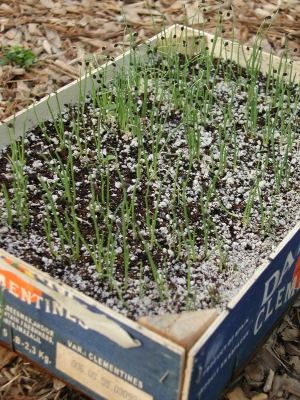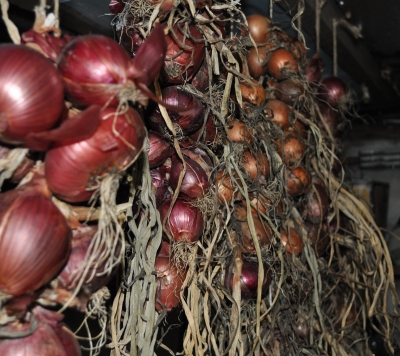COMPOST TEA: SNAKE OIL OR PLANT ELIXIR?
/26 Comments/in Gardening, Pests, Soil/by Lee ReichIs the Jury Still Out on Compost Tea?
In gardening, as in life, you can’t help but want to love some things, compost tea being one of them. After all, compost is good, tea is soothing, so what’s not to love about compost tea?
Perhaps it depends on how you brew your tea. Traditional compost tea was and is made by hanging a burlap bag of compost in water, then diluting and drenching the ground or the potting mix of a potted plant with the nutritious, coffee-brown liquid.
More recently, “aerated compost tea” (ACT) has soothed gardeners from coast to coast, the result mostly of the promotional efforts of soil scientist Dr. Elaine Ingham. This tea is brewed similarly to the traditional tea, except that extra foods, such as molasses (honey would seem more in keeping with the tea theme), brewers yeast, and bran, are also added, and — most important — the tea is aerated throughout the brewing process.
The soothing effect from ACT is not nutritional, but biological. You spray the tea on leaves or soil to spread beneficial microorganisms leached from the compost whose populations were beefed up by all that aeration and added nutrients. These happy microbes fight off attack by pathogens and insects, perhaps by making the offenders sick or unable to reproduce, perhaps by making the plants more healthy, or any one of a number of other hypothesized manners.
Coming from their home in the dark, moist, nutrient-rich innards of a compost pile, could these friendly microbes really be expected to survive on the bright, dry, nutrient-poor surface of a leaf? And evolutionarily-speaking, when would Mother Nature ever have made provisions for compost, let alone compost tea, let alone ACT microbes, to colonize a leaf and do good there? But this is all speculation; surely someone must have tested whether or not compost tea is really “soothing” to plant life.
How to Really Test Effectiveness
A slew of gardeners and farmers have tried ACT and can attest to its benefits. Matter of fact, a whole industry is dedicated to testing composts and compost teas, even selling compost tea brewers and compost tea itself.
The way to truly ascertain the efficacy of compost tea is to subject it to the same scientific scrutiny as you would anything else: Come up with a hypothesis (such as “Compost tea prevents powdery mildew of squash plants”) and then design an experiment to test the hypothesis. Said experiment would need both treated (compost tea sprayed) and control (water sprayed) plants. Most gardeners and farmers go to the trouble of spraying compost tea because they believe it will be effective, so are not willing to leave a portion of untreated (control) plants. Their endorsements, then, must be taken with a grain of salt, and the same must be said for endorsements from anyone reaping financial gain from compost tea.
One treated and one control plant, even one treated and one control plot of plants, would not be sufficient for a good test. Biological systems are complex. Grow 10 tomato plants under exactly the same conditions and some will grow a little more, some a little less than the others. With too few test plants, natural variations in plant growth might overwhelm variation due to a treatment. With enough plants to even out and offer a measure of natural variations in, say, plant growth, effects of a treatment are better parsed out.
And finally, randomization is needed to even out any effects of, say, location. Perhaps one side of a plot is more windy, or the soil is slightly different, or there’s a bit more sunlight. Rather than have all the treated plants cozied together growing better or worse because of this added effect, even out these effects by randomizing the location of treated and control plants.
Now you’ve got an experiment. Using a few arithmetic formulas or, these days, a computer program, you plug in the numbers and come up with a probability of an effect of the treatment. In agriculture, a 90% or 95% probability is usually considered sufficient. You can then answer “yea” or “nay” to the hypothesized question, in this example, “Does compost tea prevent powdery mildew of squash plants?” with a 90% or 95% confidence level
Okay, I’ll Try It
I have a friend who is a big proponent of compost tea. Finally, he convinced me to give it a try but only after I made him agree to supply me with a brewer, some compost, and explicit instructions, just to avoid his finding excuses for failure of the tea treatment.
A red flag went up when he advised me not to use it in my vegetable garden because it was “too organic.” I ended up, on his suggestion, spraying a few strips down my lawn and parts of some bean rows on a friend’s farms.
This admittedly nonscientific test conclusively showed no benefit at all from the tea.
Snake Oil, Mostly
So what’s the scientific verdict on compost tea? The answer is not so simple, in part because it depends whether the reference is to traditional compost tea or ACT, the kind of plant, the compost ingredients, how long the tea is brewed, how often tea is applied, etc.
Good experiments have been performed, from which the following general conclusions can be made: 1) ACT is not reliably beneficial (and often has a negative effect or spreads human pathogens such as Salmonella); 2) Traditional compost tea has been shown to be often but only mildly beneficial for root diseases; 3) If sufficiently, but not too, dilute, either ACT or traditional compost tea can supply nutrients to feed plants.
My pea plants succumb early every summer to some root disease, possibly fusarium. I am tempted to drench the soil for the peas with traditional compost tea. Perhaps I’ll even set it up as a crude experiment, keeping in the back of my mind the admonition of Charles Dudley Warner (My summer in A Garden, 1871), “I have seen gardens which were all experiment, given over to every new thing, and which produced little or nothing to the owners, except the pleasure of expectation.”
Mostly, though, I’ll continue to do what I’ve been doing, spreading compost on top of the ground and letting rainwater make the tea.
MANURE ABSOLVED, PRUNING STARTED
/12 Comments/in Design, Fruit, Gardening, Pruning, Soil/by Lee ReichHorse Manure: Not Guilty, So On To Pruning
A dark cloud no longer hangs over my horse manure, that is, the horse manure that I occasionally truck over here to add to my compost piles. I wrote a few weeks ago about the possibility of herbicide that, when applied to hay, retains its toxic effect when an animal eats the hay and even, for a long time, after that animal’s manure has been composted or spread on the ground.
My herbicide residue concerns were soothed with a simple assay that showed satisfactory growth from bean seeds in both hay that was suspect and hay of known integrity. Also, the bedding in the horse manure is mostly wood shavings rather than hay.
But another ugly dragon kept raising its head above the manure. Another chemical, this time, Ivermectin, a de-worming medication given to horses (and other animals). Ivermectin or its metabolites might pass through the animal and injure soil dwelling creatures such as beneficial nematodes and earthworms. Past studies have shown negative effects on, for example, “dung fauna and degradation of faeces” (to quote a research paper from 2006).
Ivermectin is, admittedly, a very useful material, even useful in humans to combat lice, bedbugs, and some more frightening tropical afflictions such as river blindness and elephantiasis. Agriculture is always a balancing act, but I like to keep my soil-dwelling partners happy.
So I was gladdened when a veterinarian recently directed me to a Stanford University publication that summarized research findings on the environmental effects of Ivermectin. To whit: Ivermectin is excreted and it can affect earthworms, springtails, and other fauna. But it degrades quickly at summer temperatures (1-2 weeks, but much longer in winter) and within a day or two of exposure to bright sunlight. With temperatures within my compost bins reaching 150°F., or more, with the compost sitting many months before use, and with the compost being spread on top of the ground, little Ivermectin would end up in the soil. And soil anyway naturally has low levels of this compound.
Snow Makes Me Taller
Let’s look aboveground, at stems; there’s pruning to be started. With well over a foot of snow on the ground, I turn my attention to taller plants. The snow is actually an advantage because, with snowshoes on, I can reach more than a foot higher into the branches without a ladder.
For now, I’m going to start with the easiest pruning, mostly with plants that don’t need regular pruning beyond removing dead, diseased, broken, and grossly misplaced branches. Right here, such plants include pawpaws, plums, cornelian cherries, and a teenage honeylocust tree. Light is important for fruit production from the fruit trees and, generally, to keep diseases and insects at bay, so I also prune away enough branches to let remaining branches bathe in sunlight.
I go at the pawpaws with one more goal in mind, to keep fruit from forming either too high in the tree or two far out on the limbs. Pawpaw trees will grow 15 to 25 feet high but I harvest fallen fruit from the ground. By my estimation, fruit can make a soft landing, undamaged, from a height of about 10 feet onto mulched ground. So I lop back the tops to weak side branches at about that height.
Each pawpaw flower is a multiple ovary, potentially spawning up to nine fruits, each of which can weigh more than half a pound. That’s a lot of weight perched onto the end of a branch, so I shorten long branches to decrease leverage of that fruit load.
(More about all types of pruning on all kinds of plants in my book, The Pruning Book.)
A Beautiful Climber
I actually did begin pruning a few weeks ago, before the first snow fall. The plant was hydrangea — no, not the common bigleaf hydrangea which has many people scratching their heads about how to prune, but climbing hydrangea (Hydrangea anomala subsp. petiolaris).
Climbing hydrangea is one of the most beautiful vines, even right now as the peeling, pale cinnamon, bark is in focus among the leafless stems. All summer long, the stems are clothed in lustrous green foliage and, in early, summer clusters of white flowers twinkle against that backdrop like stars in the dark sky.
As expected, the vine took a few years to get firmly established. Now it threatens to engulf my brick home except that I want to restrict it to only the north wall. Every year now, I prune back stems creeping like groping fingers around the east and west walls. And each year the flower stems reach further directly out from the wall, so I also shortened them.
The present pruning doesn’t permanently subdue the plant. This summer, I’ll again shorten the wandering stems, and I’ll be back at it again next winter and for winters to come.
FIRST SOWINGS OF THE YEAR, DEADLINE MISSED
/4 Comments/in Gardening, Soil, Vegetables/by Lee ReichOnions & More, Late But They’ll Be Fine
I missed my deadline by four days, sowing onion seeds on February 5th rather than the planned February 1st. That date isn’t fixed in stone but the important thing is to plant onions early.
Onions are photoperiod sensitive, that is, they respond to daylength (actually, night length, but researchers originally thought the response was to light rather than darkness, so the phrase “daylength sensitive” stuck). Once days get long enough, sometime in June, leaf formation comes screeching to a halt and the plants put their energies into making bulbs. The more leaves before that begins, the bigger the bulbs.
Plants from seeds sown outdoors — towards the end of March — won’t have as many leaves as plants given a jump start indoors. I like big bulbs; hence the early February sowing.
Fresh Seeds & Mini-furrows in a Plastic Tub
First step on my way to onion-dom is to get fresh seeds. Onion seeds are relatively short lived and I want to give the plants plenty of time to grow. I don’t risk delays from poor germination and replanting of old seed.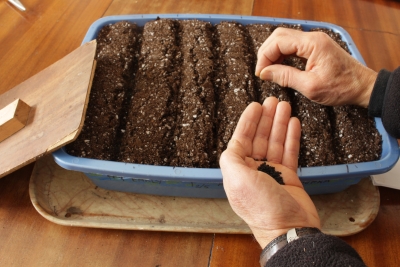
Seeds get sown in a miniature “field:” A plastic tub 18 inches by 12 inches, with drainage holes drilled in its bottom and filled 4 inches deep with potting soil. Some weed seeds are unavoidably lurking in the garden soil and compost in my homemade potting mix, so I top the potting mix with a one inch depth of a weed free, 1:1 mix of peat moss and perlite.
The edge of a board pressed into the firmed soil mix in the tub makes furrows, 6 of them equally spaced and about 1/2 inch deep within the tub. Into each furrow go onion seeds, sprinkled at the rate of about 7 seeds per inch. Once the furrows are closed in over the seeds, I water thoroughly and, to avoid washing away seeds, gently.
Covered with a clear pane of glass and warmed to 70 to 75° F, the seeds should appear as grassy sprouts above the soil mix within a couple of weeks. From then on, my goal is to keep the plants happy with abundant light and water as needed. They get a haircut, their leaves snipped down to 4 inches, whenever they get too floppy. The compost and alfalfa meal in the potting mix should provide sufficient nourishment to the seedlings until they are ready for the great outdoors. That deadline is April 15th, weather permitting.
Other Cool Temperature Seeds Join the Party
Onions won’t be alone on the seedling bench in the greenhouse. I’m also now sowing seeds of celery, celeriac, and leek. All, like onion, need a long period of growth before they’re ready for outdoors.
These seeds get sown in furrows in small seed flats from which the seedlings, once they have two leaves, are gingerly lifted and cozied into waiting holes poked into the potting mix filling seed trays with individual cells. Little growing space is needed because a single seed flat can be home to a few kinds of seeds and the celled trays in which the seedlings grow until planted outdoors can house about two dozen plants in a square foot.
I’m sowing lettuce in a similar manner. In contrast to celery and company, lettuce grows quickly. It’s needed to fill in gaps opened up from winter harvests of kale, lettuce, mâche, claytonia, celery, and parsley in the greenhouse, and should be ready to eat in April.
Nature & Nurture & the Spiciness of Onions
Last year’s onions were abundant, large, sweet, and juicy. Anticipating their not keeping well, we ate them quickly, pulling the last ones from their hanging braid in the basement sometime in November. These were so-called European-type onions, varieties such as Ailsa Craig and Sweet Spanish.
Next year we should have fresh onions for soups and stews on into winter because I’m growing some American-types, New York Early and Copra. American-type onions are actually sweeter than European-type onions, but their sweetness is masked by their increased pungency. That pungency comes from sulfur compounds, which are vaporized during cooking. Those sulfur compounds are also what help these onions keep longer.
Soil enters the picture when it comes to onion flavor and storability. Sulfur is an essential plant nutrient and the more sulfur in the soil, within limits, the more sulfur in the onions. Sulfur is a key component of organic matter, so my compost-rich soil (with a whopping 15% organic matter) should have plenty of sulfur.
Still, I’m thinking about spreading sulfur, the same pelletized sulfur I use to maintain soil acidity beneath my blueberry bushes, on half my onion beds to see if flavor or storagability are noticeably affected.

